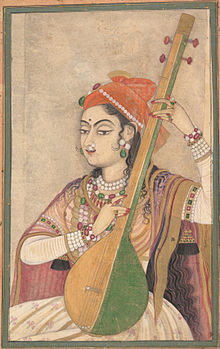Pandavani
| Music of India | |
|---|---|

A Lady Playing the Tanpura, ca. 1735 (Rajasthan)
|
|
| Genres | |
|
|
| Media and performance | |
| Music awards | |
| Music festivals | |
| Music media | |
| Nationalistic and patriotic songs | |
| National anthem | Jana Gana Mana |
| Regional music | |
|
|
Pandavani (lit.: Songs and Stories of the Pandavas) is a folk singing style involving narration of tales from the ancient Indian epic Mahabharata. The singing also involves musical accompaniment. Bhima, the second of the Pandava is the hero of the story in this style.
This form of folk theatre is popular in the central Indian state of Chhattisgarh and in the neighbouring areas of Madhya Pradesh, Orissa and Andhra Pradesh.
Jhaduram Dewangan and Teejan Bai are the most renowned singers of this style. Among contemporary artists, Ritu Verma is popular along with others such as Shantibai Chelak and Usha Barle
The origins of this singing style are not known and according to its foremost singer Teejan Bai, it might be as old as the Mahabharata itself, as few people could read in those times and that is how perhaps they passed on their stories generation after generation. Traditionally, Pandavani was performed exclusively by men. Since the 1980s, however, women also began to present Pandavani.
Pandavani can be understood as a part of the tradition of the tellers-of-tales present in every culture or tradition (like Baul singers of Bengal and Kathak performers), where ancient epics, anecdotes and stories are recounted or re-enacted to educate and entertain the masses.
Pandavani, literally means stories or songs of the Pandavas, the legendary brothers of Mahabharat, and involves the lead singer, enacting and singing an episode (called 'prasang') from the epic with an ektara or a tambura (stringed musical instrument), decorated with small bells and peacock feathers in one hand and sometimes kartal (a pair of cymbals) on another.
During a performance, as the story builds, the tambura becomes a prop, sometimes to personify Bhima's 'gadaa' mace, or Arjun's bow or chariot, or the hair of queen Draupadi or Dushasan thus helping the narrator-singer play all the characters of story. The form does not employ any stage props or settings. With the use of mimicry and rousing theatrical movements, once in a while the singer-narrator breaks into an impromptu dance at the completion of an episode or to celebrate a victory in the story being retold. The singer is usually supported by a group of performers on Harmonium, Tabla, Dholak, Manjira and two or three singers who sing the refrain and provide backing vocals.
...
Wikipedia
